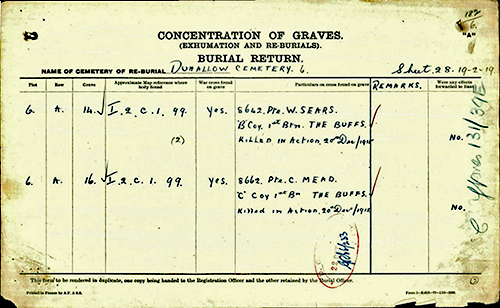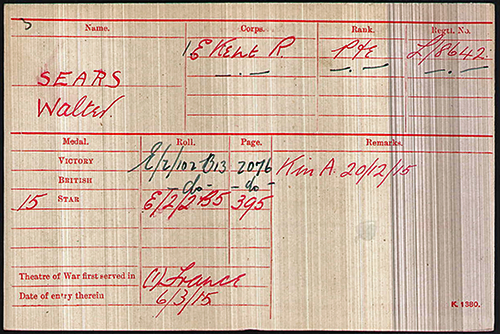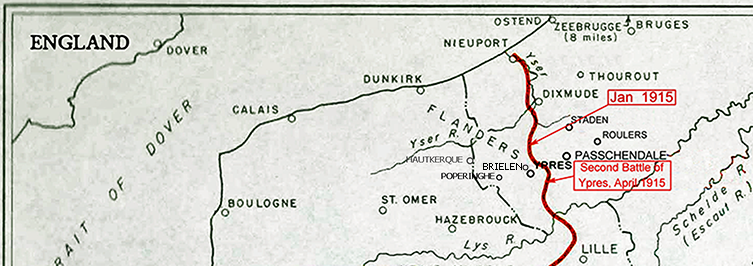First World War Project
Walter William Richard SEARS (of Newnham)
b. 4th August 1889 Private, Service Number L/8642 |

The Commonwealth War Graves Commission (CWGC) records - Son of Mr. and Mrs. W. Sears, of Sittingbourne, Kent; husband of Minnie Hill (formerly Sears), of 20, New Street, Ashford, Kent.
According to Walter's baptism record, he was born in Lynsted on 4th August 1889 and baptised in Lynsted Church on 22nd September that year. Before he was one year old his parents moved to "Royal Oak", beersellers, Newnham Street, Newnham. His father, Walter was a carpenter, married to Mary Ann A. Sears (née Towner). Walter Sears, had two older step-sisters Lily Maud Towner and Alice E.C. Towner (daughters from his mother's first marriage), and one younger brother Wilfred.
Both Walter's step-sisters, Lillie Maud Augusta Towner and Alice Edith Constance Towner, married locally on the same day (2nd November 1904) to Ernest Robert Kite and Edgar Ernest Chapman respectively.
Military Records
Records prior to 1914, reveal some insights into the early life of Walter in the absence of surviving records for the 1914-18 War. In his attestment documents, dated 13th March 1907, he is described as 5 feet, 4½ inches tall, weighing 104 pounds (47 Kilograms). Sallow complexion with blue eyes and brown hair. He had four decayed teeth. None of this disqualified him as he was passed "fit" for the militia.
Interestingly, in these documents, Walter only lists three blood relatives. He records his father (also Walter), his mother ("Polly") and his younger brother (Wilfred). His father was living as the beer-seller at the "Royal Oak", beer seller, Newnham. This is the half-timbered cottage ("Foxwood End") that is the last cottage on the left as you leave Newnham on the way to Doddington. Walter does not include his two step-sisters from his step-mother's first marriage to Robert Towner (a policeman). The omission of his step sisters is because only blood relatives were asked for.
Walter was attested at Canterbury when he confirmed he lived in Newnham and worked for Mr. H. Jordan of Forge Farms, Newnham. At the declared age of 18 years and 6 months, Walter tells us he is an unmarried Farm Labourer. At this time he enlists for six years to the 3rd Battalion, The Buffs. At this time, the 3rd Battalion was the reserve battalion. However, after just seven months in training, on 9th October 1907 Walter purchased his discharge for £3. His character being confirmed as good.
Duhallow Cemetery Advanced Dressing Station (ADS) Cemetery
 After the Armistice, Duhallow Cemetery was enlarged when graves were brought into this cemetery from isolated sites and a number of small cemeteries on the battlefields around Ypres. Special memorials commemorate a number of casualties known to have been buried in two of these cemeteries, Malakoff Farm Cemetery, Brielen, and Fusilier Wood Cemetery, Hollebeke, whose graves were destroyed by shell fire.
After the Armistice, Duhallow Cemetery was enlarged when graves were brought into this cemetery from isolated sites and a number of small cemeteries on the battlefields around Ypres. Special memorials commemorate a number of casualties known to have been buried in two of these cemeteries, Malakoff Farm Cemetery, Brielen, and Fusilier Wood Cemetery, Hollebeke, whose graves were destroyed by shell fire.
There are now 1,544 Commonwealth casualties of the First World War buried or commemorated in this cemetery, 231 of the burials unidentified.
"Concentration of Graves, Exhumation and Re-Burials" records show Walter's remains were recovered and reinterred at Map Ref: I.2.C.1.99. Burial Cross in Plot 6, Row A, Grave 14H. Stone 945.
Links with Private Charles Frederick Mead.
The only other Buff soldier to die locally on the same day was Private Charles Frederick Mead (L/8600 - given in CWGC Records) in Company "B". Son of William Henry and Elizabeth Ann Mead, who had emigrated to live at 27, Hallaran St., Leichhardt, Sydney, New South Wales. It isn't clear when they emigrated, but their son, born in Milton-next-Sittingbourne, enlisted at Chatham with a Regimental number only 42 before the Regimental Number of Walter Sears (L/8642) who is in Company "C". So, it is more than likely they knew each other well and their experiences would have been shared right up to the end. The Concentration Record for Private Mead shows a mis-reading of his Regimental Number.
 From their Regimental Numbers alone, both Private Charles Mead and Private Walter Sears, first enlisted between 19th March 1907 and 18th November 1908. Neither saw overseas service before war broke out in 1914.
From their Regimental Numbers alone, both Private Charles Mead and Private Walter Sears, first enlisted between 19th March 1907 and 18th November 1908. Neither saw overseas service before war broke out in 1914.
The 1st Battalion, East Kent Regiment, at the time of their enlistment was stationed at home. Between 1906 and 1910, the 1st Battalion was in Aldershot/Dover after which it was stationed in Ireland (Dublin). When war was declared, the Buffs were among the first troops to travel to France as part of "The Old Contemptibles" - the British Expeditionary Force from September 1914. However, the Medal Card shows that Walter didn't arrive in France until 6th March 1915. In the absence of further surviving military documents for either of these men, we cannot be any more detailed in understanding the experience of Walter Sears before the outbreak of war. But we can look into the Regimental Diaries to learn what he first saw in France and then under what conditions he lost his life.
Circumstances of the Death of Private Walter William Richard Sears
Landing in France on 6th March, Walter's journey to the Front would have taken a few days.
As Walter was travelling to the Front, the 1st Battalion were in trenches at RUE DE BOIS charged with digging saps (to join forward and support trenches) behind Company "C". Adjacent to Company "B", the Royal Engineers began two mines towards the enemy. On 9th March the British artillery opened fire between 4 & 5 a.m. and the 1st Battalion prepared to be relieved back to ARMENTIERES on 10th March, when Lieutenant E.H. Allen and 50 "other ranks" joined the Battalion in billets. It is likely that Walter was one of this group or the next group (16th March).
On 15th March, 1st Battalion entrained at 12.30 am, taking them in stages to ARMENTIERES ANNEX and VLAMERTINGHE and marched to camp. On 16th March the Battalion entrained again for ARMENTIERES then detrained at NIEPPE and marched to billets. 2nd Lieutenant E.H. Fletcher arrived with 32 "other ranks". On 17th March the Battalion was inspected in GRANDE PLACE by General Sir Horace Smith-Dorrien, commanding the 2nd Army. In his Battalion Orders he stated: "The Army Commander Sir Horace Smith-Dorrien was greatly pleased with the appearance and turn out of the Battalion yesterday. The Corps Commander expressed to the Commanding Officer his satisfaction on the condition of the rifles and boots and stated that these were the best he had ever seen."
By 21st March Walter would have seen his first front-line trenches as the Battalion returned to RUE DE BOIS until 27 March when they were relieved back to ARMENTIERES. This pattern repeated through April and May; coloured by regular exchanges of rifle, mortar and heavy guns with some losses for The Buffs. On 31st May, on being relieved back to BAILLEUL, the 16th Infantry Brigade was inspected by The Prime Minister (Mr Asquith). They were also visited by Brigadier General Lynden Bell.
In June, the Battalion marched to WITTENHOEK, 4 miles south of POPERINGHE, where they went into bivouac. Here they met up with the 2nd Battalion under command of Major Worthington. "The Battalions had not met since 1904 and previous to that had not met since 1882 at SINGAPORE.
In August, the Battalion moved to LE BRIQUE trenches (where Percy Crowhurst, of Oare, was lost) to face a prolonged intense shelling, mortaring, machine gun and rifle fire. They also made significant efforts to improve the trenches and defences. This month also saw a major effort to retake trenches previously lost - the alternative being to withdraw still further to a defensible position. Day and night, fighting, injury and losses continues as slow progress was made. By the time they were relieved by the Leinster Regiment (12th August) there had been 192 casualties: 25 killed; 162 wounded; and 5 missing.
By comparison with the fraught fighting of August, September was quieter. By November, the trenches were water-logged and presented a whole new problem for survival. Water reached the hips in some trenches.
Trench warfare was a relentless experience for Walter Sears with only limited relief (normal for all units) but with some isolated periods of behind the lines in Ypres (Menin Gate).
This brings us to December 1915.

Since 26th November, 1st Battalion had been relieved back to "Camp "C" - Wood A30" where "company training" dominated the next few days. Parades took place on 2nd and the morning of 4th December followed by a march to relieve troops at HOUTKERQUE. "The march was successfully accomplished and the Battalion billeted in scattered farm houses about 1½ miles North of the village." They remained at HOUTKERQUE until 9th December when "The Brigade marched past the Division Commander (Major General Charles Ross) near DROGLAND (J12 b8.3) and the Brigadier. It had been intended to carry out an outpost scheme, but this was postponed owing to the bad weather." The Battalion remained at HOUTKERQUE until 15th December.
15th December: "Last day of Brigade rest. During this period the general training of the Battalion was much hampered by frequent rain. However, good work was done. Some Companies organising sports, cross-country runs, etc. all of which much benefited the men's health."
16th December: "Battalion proceeded by route march to Camp C. (Brigade goes into line)."
17th and 18th December: "Battalion in Camp "C"."
19th December: "Battalion in Camp "C". Gas attack about 4.15 am. Heavy shelling by both sides. Battalion occupied breastworks and other subsidiary defences on the BRIELEN road, returned to breakfast about 8.0 am and "stood by" for the rest of the day."
20th December: Battalion relieved 2/Bedfordshire Regiment - FORWARD COTTAGE trenches [see detailed Map]. Country in terrible condition owing to rains and heavy shelling. Many trenches unoccupiable and the line held chiefly by isolated posts. Battalion in S13b very hot. Occupied with heavy howitzers most of the night. 2/Lieutenant E.K. Smith wounded, 3 Other Ranks killed, 19 wounded."
[Side Note in Diary: During this period, notification was received of the award by the French Republic of the Cross of the LEGION OF HONOUR to Captain Guy Lee in recognition of his services at GRENADE SCHOOL II ARMY. Letter of congratulation sent by Officer Commanding, 1st Battalion.]
So it was that Walter Sears had by this time witnessed hard fighting, including a gas attack the day before he was killed by Heavy Battery and Howitzer exchanges along the Front Line. He died in the flooded trenches in sucking, slimy glutinous mud - the advanced dressing station was 'on the spot' and could do nothing for him. We don't know if he had been affected by the earlier gas attack.
21st December: "In trenches. Troublesome day, much shelling on both sides. 2 Other Ranks wounded, one killed."
22nd December: "In trenches. 2nd Lieutenant E.K. Smith died of wounds in hospital. Inter Company reliefs and ration parties much hampered by thick slimy mud. In places it was impossible to move, men were literally stuck.
23rd December: "2nd Lieutenant N. Graffenhagen wounded, 2 Other Ranks killed, 5 wounded."
24th December: " The Battalion relieved by 8/Bedfordshire Regiment and returned to camp "C". Many men were suffering severely from "trench feet" owing to the terrible condition of the trenches and the lack of thigh boots. All in Camp about 2.0am 2nd Lieutenant Graffenhagen died of wounds."
Changes in the Command Structure and Messages to the troops.
25th December: "CHRISTMAS DAY. "A" and "C" companies and Head Quarters to POPERINGHE - "B" and "D" Companies to Canal Bank. Thus many of the Battalion spend XMas 1915 both in in the trenches, in the wood and in Billets. - "Field Marshal Sir J. French has expressed his regret that he is unable to come and say good-bye to the VI Division. He wishes to thank all ranks for their splendid work and devotion to duty." 3 Other Ranks wounded.
26th December: From General Officer Commanding VI Corps. "Although I have already expressed to you and your Brigade Commanders the admiration I feel for the gallant stand made by those under their command against the recent German Gas attack. I should like to place on record how very highly I value the services rendered by all ranks. I do not think that the importance of their success can be over-estimated. It has established a complete confidence in our power of defence which had been severely shaken by the German Gas Attach in the Spring, a confidence which, however, had never deserted the VI Corps."
28th December: "The following message received from H.M. The KING. "Another Christmas finds all the resources of the Empire still engaged in war, and I desire to convey on my own behalf and on behalf of the Queen a heartfelt Xmas greeting and our good wishes for the New Year to all who on Sea and Land are upholding the honour of the British Name. In the Officers and men of my Navy on whom the security of the Empire depends. I repose, in common with all my subjects, a trust that is absolute. On the officers and men of my armies whether now in France, in the East or in other Fields. I rely with an equal faith, confident that their devotion, their valour and their self-sacrifice will, under good guidance, lead to victory and an honourable Peace. There are many of their comrades now, alas, in hospital, and to these brave men, also, I desire with the Queen, to express our deep gratitude and our earnest prayer for their recovery.
Officer and Men of the Navy and Army another year is drawing to a close as it began in toil, bloodshed and suffering; but I rejoice to know that the goal to which you are striving draws nearer into sight.
May God bless you and all your undertakings." signed George R.I.
Record of Effects
Record of "Effects": Sole beneficiary wife, Minnie. Sent £3 2s. 8d. followed by War Gratuity of £7 10s. 0d. after the close of the war (Certified 6th June 1919; the same as awarded to Charles Mead, which is indicative that their military story was largely mirrored.)
Walter was awarded the 1915 Star, British War and Victory Medals. Medals Page
Extended Family (draft)


 World War 1 Pages
World War 1 Pages